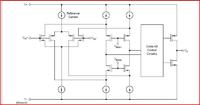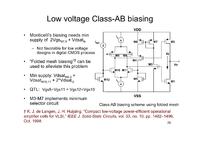cmos_ajay
Full Member level 2

Hello,
Attached is a picture of a opamp schematic.
It represents TEXAS Instruments op-amp OPA350 as seen in datasheet.
This opamp drives very high capacitive loads ( micro farads ) when connected as a unity gain buffer. It has gain > 100dB . The first stage is a standard folded cascode.
a] What do you think is the architecture of the class AB control circuitry seen in the picture ??
b] To drive high capacitive loads, the miller compensation will 'not' be useful at all
c] Is there any other opamp architecture to drive large capacitive load with high gain and bandwidth ??
Thanks.
Attached is a picture of a opamp schematic.
It represents TEXAS Instruments op-amp OPA350 as seen in datasheet.
This opamp drives very high capacitive loads ( micro farads ) when connected as a unity gain buffer. It has gain > 100dB . The first stage is a standard folded cascode.
a] What do you think is the architecture of the class AB control circuitry seen in the picture ??
b] To drive high capacitive loads, the miller compensation will 'not' be useful at all
c] Is there any other opamp architecture to drive large capacitive load with high gain and bandwidth ??
Thanks.





